#lab created yellow diamond
Explore tagged Tumblr posts
Text
Why Lab Grown Yellow Diamonds Are a Popular Choice

Lab grown yellow diamonds have become increasingly popular in recent years, particularly among those seeking a unique yet sustainable alternative to natural diamonds. These diamonds are created in laboratories, mimicking the conditions under which natural diamonds form, but in a controlled environment. Let’s explore the reasons why lab grown yellow diamonds are gaining traction in the Indian market and beyond.
1. Cost-Effective and Accessible
Lab grown yellow diamonds are more affordable than their mined counterparts, often costing 30-40% less. This makes them an attractive option for those who want the beauty and luxury of diamonds without the hefty price tag. The lower cost is due to the fact that the process of growing diamonds in labs is far more efficient than mining, which involves extensive labour, transportation, and middlemen.
For those looking to invest in high-quality diamonds for special occasions like weddings or engagements, lab created yellow diamonds offer a cost-effective solution without compromising on the look or quality.
2. Environmentally Friendly
Lab grown diamonds are a more sustainable and eco-friendly alternative to traditionally mined diamonds. The mining of natural diamonds has long been associated with environmental damage, including deforestation and water pollution. Lab created diamonds, on the other hand, require significantly less energy and resources to produce. Since these diamonds are made in a lab, there’s no need for large-scale extraction processes, making them a much greener option for eco-conscious buyers.
This sustainability factor is especially important in today's world, where consumers are becoming more mindful of their environmental impact and opting for products that align with eco-friendly values.
3. Ethically Sourced
One of the major concerns associated with natural diamonds is the ethical issues surrounding their sourcing. Conflict diamonds, also known as blood diamonds, have a long history of being linked to human rights abuses. Lab grown yellow diamonds completely eliminate these concerns. Since they are created in a controlled environment, unethical labour practices or conflict zones are not involved.
For socially responsible buyers, the assurance that their diamond purchase is free from human exploitation adds immense value.
4. Enhanced color Options
Lab created yellow diamonds come with the advantage of consistent and vivid color. In the natural environment, yellow diamonds get their color from traces of nitrogen, and it can be challenging to find a diamond with the perfect hue. However, in a lab setting, this process is carefully controlled, allowing lab grown diamonds manufacturers to produce yellow diamonds with a consistent and desired color intensity.
Whether you are looking for a soft, pale yellow or a vibrant canary yellow, lab grown diamonds offer a wider range of options to meet your preferences.
5. Superior Quality and Durability
Many people assume that lab grown diamonds are inferior to natural ones, but this is not the case. Lab created diamonds are identical to natural diamonds in terms of chemical composition, physical properties, and appearance. They have the same brilliance, fire, and hardness, making them just as durable and beautiful.
In fact, lab grown yellow diamonds often come with fewer inclusions, which means they can have better clarity compared to natural diamonds. For buyers who prioritise quality, this makes lab created yellow diamonds an excellent choice.
6. Support from Manufacturers
The availability of lab grown diamonds in India is expanding, with more manufacturers offering these gemstones across the country. Indian jewellers are now embracing lab grown diamonds, which means customers have easier access to customised jewellery options featuring yellow diamonds. As the demand continues to grow, lab grown yellow diamond manufacturers are working to innovate and enhance the quality of their products, making them even more appealing.
Conclusion
In conclusion, lab grown yellow diamonds are gaining popularity for their affordability, ethical production, environmental benefits, and quality. As more buyers in India and across the globe become aware of the advantages of lab created diamonds, it’s clear that these stunning gemstones are here to stay. Whether for an engagement ring, wedding jewellery, or a unique statement piece, lab grown yellow diamonds offer a brilliant and responsible alternative to mined diamonds.
#lab grown diamond manufacturers#lab grown diamond manufacturers in surat#lab grown diamond manufacturer#lab grown diamonds mumbai#cvd diamond manufacturers in surat#lab grown diamond wholesaler#lab grown diamond jewellery india#lab grown diamond manufacturers in india#lab grown diamond supplier#lab grown diamond manufacturer in india#lab grown yellow diamond#lab grown yellow diamonds#yellow lab created diamonds#lab created yellow diamond#lab created yellow diamonds#dark yellow diamond#yellow lab diamonds#yellow diamond color scale#yellow diamond color chart#yellow diamond chart#yellow diamonds color scale
0 notes
Text
For Her Unique Occasion. Vintage Vibes. A Necklace that Shows Her Personality. TheJewelryHut Vintage Inspired Victorian Style Green and White Crystalline Silver Necklace
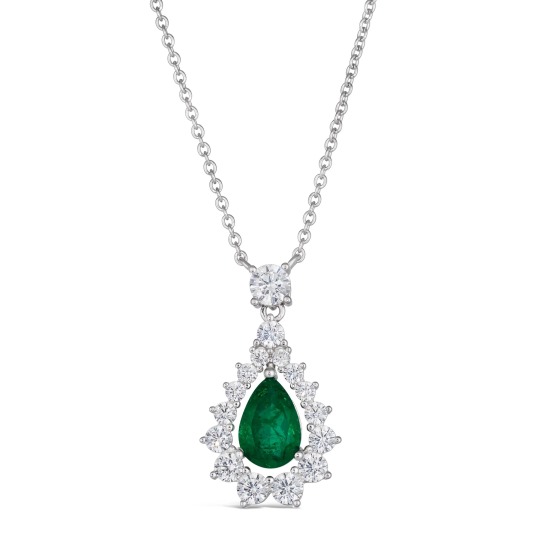
Designs Borrowed from past that Appeal to Sophisticated Modern Woman. Steal her Heart with TheJewelryHut Vintage Inspired Style Platinum Plated 925 Sterling Silver 16 inches (16-20 inches adjustable) Carlisle Tear Drop Necklace Featuring One Pear Shape Emerald Green Color Lab Created Crystalline and Surrounded by Several White Diamond Color Lab Created Crystalline. Gems Total weight 2.5 CTTW. The Luxury of Sterling Silver that Captures her Style and Shows her attitude. Submerge Her in the Sparkle of this Elegant Necklace. Ready to Ship 3-5 Days. Main Stone Choice of Green Emerald, Blue Sapphire, Ruby Red, Aquamarine Blue, Argyle Pink, Canary Yellow and White Diamond Color Lab Created Crystalline.

Trust Confidence and Integrity. Shop TheJewelryHut. Visit the Anna Zuckerman Jewelry Gallery, Buy now and Sparkle all day: https://www.thejewelryhut.com/?page=search&itemvid=FBAB383F-03CB-9208-3EA37F39D764F87B



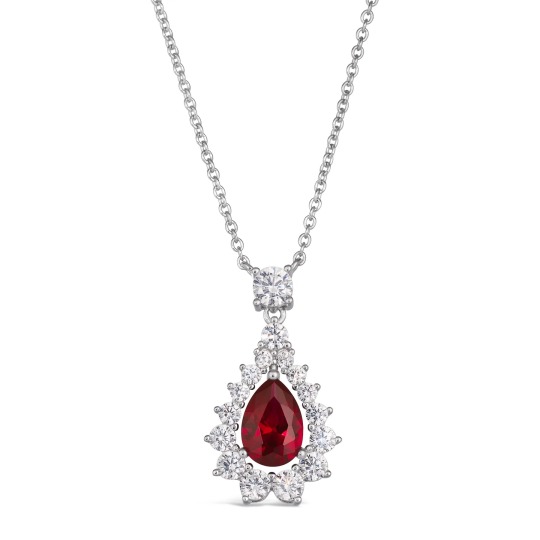

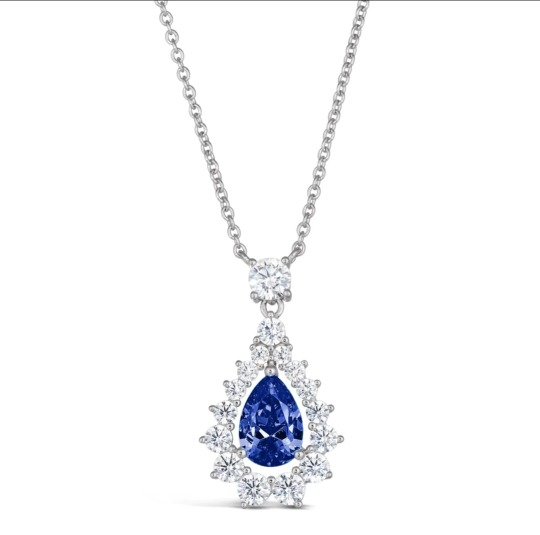
#Necklace#Sterling Silver Necklace Crystalline Silver Necklace#Aquamarine Blue color necklace#blue color crystalline pendant#CZ necklace#Lab created crystalline necklace#black dress event jewelry necklace#anniversary jewelry gift#birthday gift#jewelry near me#thejewelryhut#anna Zuckerman luxury jewelry#Elizabeth jewelry collection#Green Emerald#Blue Sapphire#Ruby Red#Aquamarine Blue#Argyle Pink#Canary Yellow and White Diamond Color Lab Created Crystalline.
0 notes
Text
#Warm Diamonds#Benefits of Warm Diamonds#lab created diamonds#lab grown diamonds#diamond#studs#4Cs#colored diamonds#engagement ring#necklace#earrings#vintage-style engagement rings#Diamond jewelry#yellow gold#rose gold
0 notes
Text

Discover the ethical and environmental benefits of Lab-Grown Diamond Rings in this informative article. Learn why more and more consumers are choosing sustainable sparkle and how to choose the perfect lab-grown diamond for your ring.
#lab-grown diamond rings#lab grown diamond rings near me#lab grown diamond rings for sale#lab created diamond rings#lab created diamond rings yellow gold#lab made diamond rings#lab created diamond wedding rings
1 note
·
View note
Text

~ GSA members with Magical Wings ╰(*´︶`*)╯💫🌟Prepare for lots of headcanons of them on this post hehe here goes :)
🌟Sir Arthur has electric magic he can create magic wings with his magic same with the other GSA members but each of them have a different element ^^ He’s really speedy with them. Arthur is quite strict since he’s leader, he’s also caring as well. But sometimes Meta Knight has trust issues with him after some point after the fall of the war. Meta is the one who mostly disobeys his orders sometimes xD he will most likely listen to Sir Falspar and Sir Dragato cuz they were there for him whenever he needs it ;w; and Sir Arthur wasn’t due to being too busy with being leader, ships, armies and stuff.
💎Sir Nonsurat has diamond/rock based magical wings. Has earth based magic. He has a new visor they make his eyes appear green. Since Nonsurat’s wings are made of rock, Galacta Knight will have a pain fighting him cuz of his heavy rock wings. It doesn’t bother Nonsurat at all. Nonsurat met Arthur since they were little they were close friends ever since. They both found a smol blue puffball, Meta Knight during a dark storm one day. Yes I headcanon Meta Knight being a creation of Nightmare. Arthur, Nonsurat are the ones who find him all lost ;0; Arthur found little Meta near NME’s labs base and decided to take him back to his ship. Meta Knight was well hidden in the GSA base. Nightmare spent a while searching for Meta but than eventually gave up..
🌊Sir Dragato has water magic and water wings. He’s a bit uptight but he’s friendly <3 Dragato knows lots about ships parts and engineering he and Falspar never met until both of them got recruited at the GSA. Dragato is also a fashion designer his favorite thing to design is capes mostly. Their both really close friends. ;w; He and Falspar were the ones who first found out about Meta Knight’s wings.
🔥Sir Falspar he has fire magic and fiery wings. Sometimes his hair changes color like the pink, orange, blue, and yellow flames :) or whenever he’s feeling a lot of emotions. Even tho he looks angy on this drawing he’s the “friendly” one in the group I promise xD Like Dragato he knows lots of spaceships how they work etc.
#my art#sydney’s art#kirby#meta knight#kirby fanart#digital art#kirby right back at ya#hoshi no kaabii#sir arthur kirby#sir nonsurat#sir dragato#sir falspar#galaxy soldier army#art#artist on tumblr#i actually have the same concept for Sword and Blade Knight that will be on another post :.D#kirby au#kirby gsa#stars
76 notes
·
View notes
Text
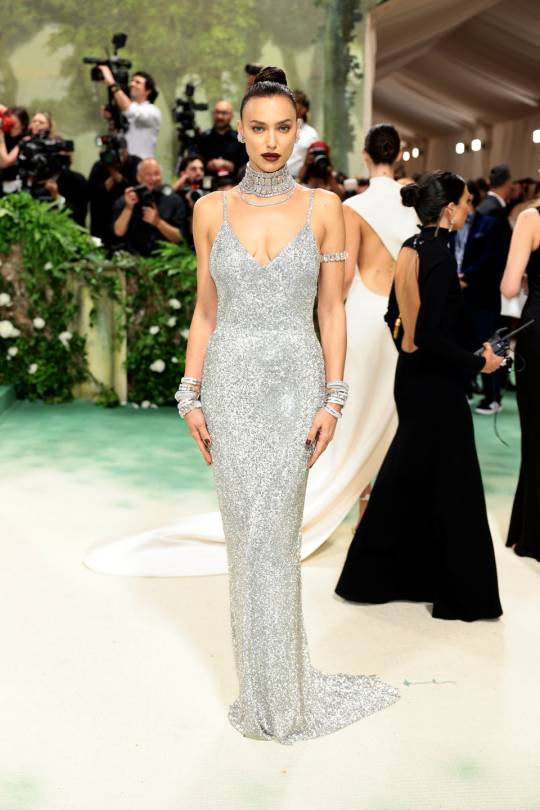
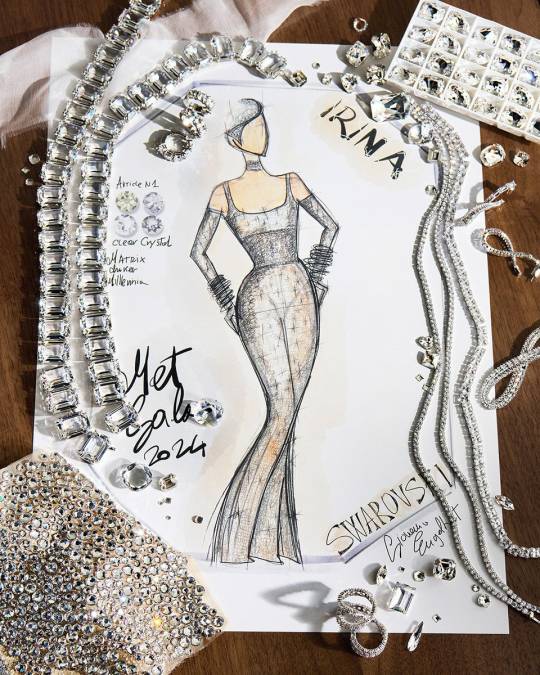

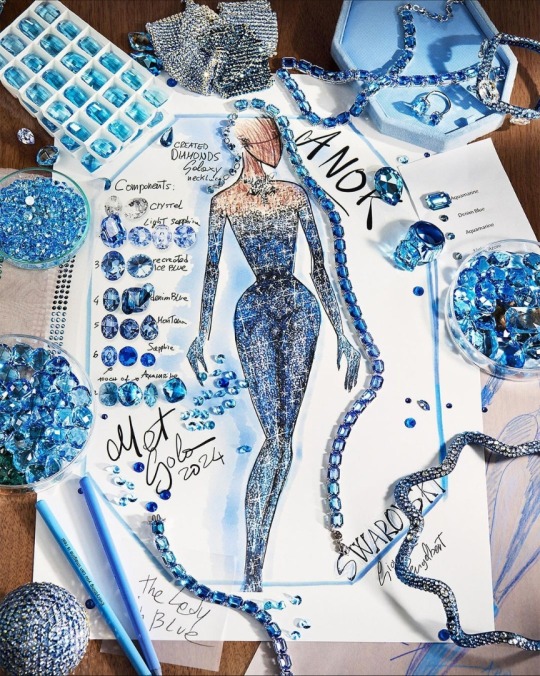

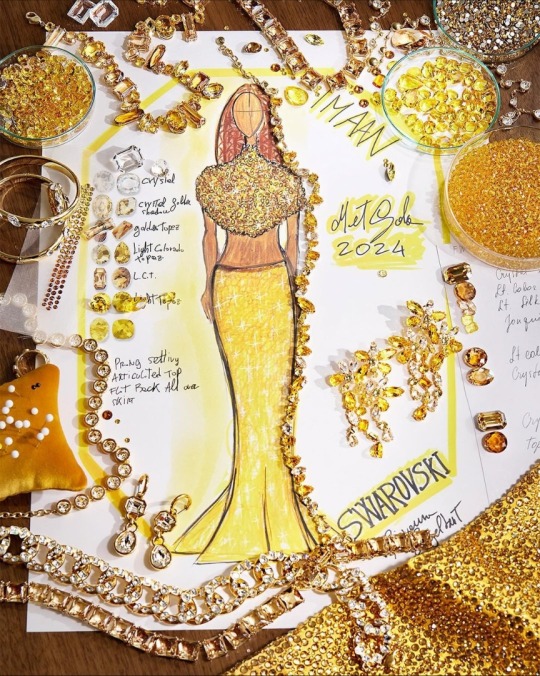
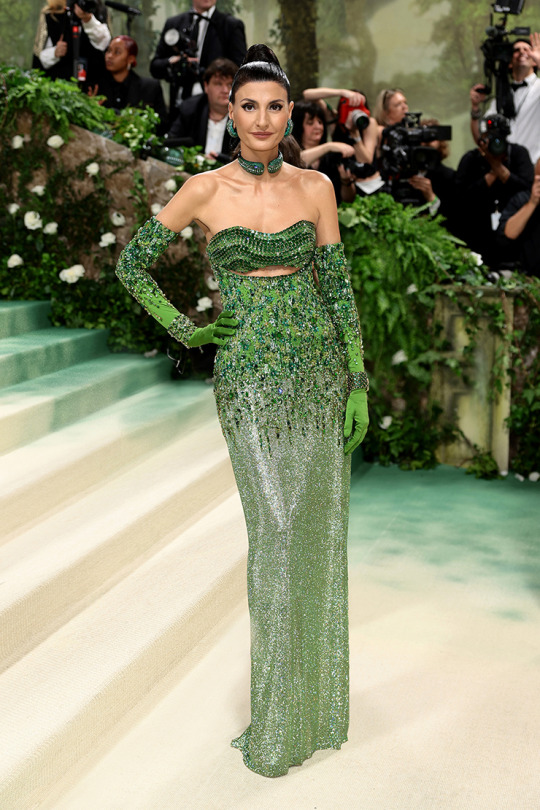
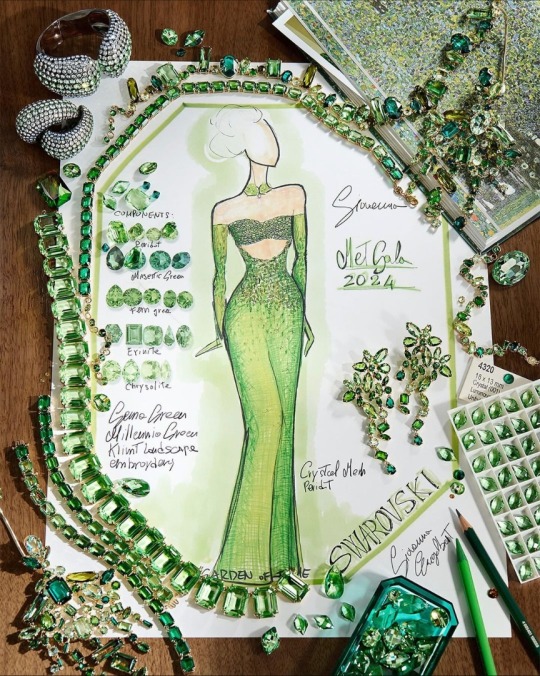


The elements by Swarovski for the Met Gala.
Air - Irina Shayk: Wore a couture-gown made from a crystal net material which took 200 hours to complete. The idea behind the design is the illusion of light flowing over her body through the movements and the crystals on the gown. To make her shine even more brightly she is wearing different bracelets and a bespoke necklace.
Water - Anok Yai: She is wearing a "futuristic tulle catsuit" made with 98.000 blue crxstals. Her look was completed with a necklace from the Galaxy collection made from 1.050 lab grown diamonds.
Earth - Giovanna Engelbert: Wore a emerald green satin gown with pearl application. The bustier is made with green Millenia crystals but the dress is made with Gema gemstones and features a gradient from emerald to peridot green. This is embellished with 55.000 crystals and pearls. She also wore matching crystallized gloves and jewellery.
Sun - Imaan Hammam: Wore a yellow two piece set. A crystallized cape with 3.456 Gema gemstones and a column skirt with 100.00 golden crystals. She was supposed to wear matching gloves with 25.000 applied crystals.
Extra for the theme: Crystal Flower - Karlie Kloss: She wore an embroidered pink silk jersey dress encrusted with 180.000 gems from Swarovski's Florere and Millenia families, and her dress seemed to be incorporated/transformed into these floral jewels. The look, which is accentuated by an ornate jeweled corset with 60.500 crystals and 75 Florere gems, took 1.600 hours to create.
All the custom looks were designed by Giovanna Engelbert, Global Creative Director of Swarovski, herself. It's also the first time Swarovski is doing custom designs for the Met Gala themselves and not just partnering with another brand to supply the jewellery. I think their ambassadors look great and it's totally on brand - how could it not be with so many diamonds and crystals - and fits the Met Gala theme with the idea of focusing on the elements at play (+plus the crystal flower).
It's crazy how much time and craftsmanship went into these designs - worn only one time!
#met gala 2024#met gala#swarovski#anok yai#imaan hammam#giovanna engelbert#irina shayk#karlie kloss#water air earth and sun#and a rose#fashion#photography#art#astronomy
23 notes
·
View notes
Note
Alright my man, I am getting into jewelry. I don't wanna know the hacks or secrets, but if you can follow my analogy here of treating jewelry like firearms, what is like the BCM 16" + Holosun class of stuff? The "you can spend better for more performance but this is the sweet spot for good quality to price." Does 24k really matter? What about lab created vs natural stones? Any cuts you'd advise against? Ideally I'd like a nice ring or four, probably a plainer gold band, and maybe emerald, ruby, and sapphire-based rings each. Something for a button down and a jacket or full classy.
Gold is easy- you want 14k as minimum, 18k-20k is cool too but ups the price. 22-24k that is do-able but extremely delicate and shouldn't be an "all the time" piece, and probably shouldn't be a ring.
Lab vs natural stones actually matter more with gemstones than diamonds. Lab rubies and emeralds for example look entirely different than their natural counterparts, lab sapphires can vary but they're very close to natural sapphires. Lab diamonds and natural diamonds are differentiated only by gemscribe #s and price.
The only diamond cut that I can't stand for both aesthetic and durability reasons is heart cut diamonds. They waste a shitload of diamond getting the heart shape and if they crack, they always crack right down the middle.
I personally prefer traditional gold (yellow) over white or rose. White gold is more durable but needs Rhodium re-plating every 1-2 years. Rose gold has a lot of copper added to it's alloy to give it its color, meaning it's less durable and will set off metal allergies in some people. Platinum is a fantastic choice for metal but it's more expensive than gold.
I'm always happy to answer jewelry questions anon, hit me up with anything else you want to know.
9 notes
·
View notes
Text
Writing another corrupted colors theme, but this time about the Chromatics
because there is something so FASCINATING to me about their story despite how little we actually know
The Locks of the Ores, the erasure of history, the revenge of the colors
Unhinged analysis time
Until Corrupted Colors, our knowledge of this universe's residents extended only to the existence of the Ores. Weaker, less powerful, lacking some of the key abilities that typically accompany Steves in their energies—because they were locked away. To access one's true potential within them, they had to snap. To break the Lock that lingered in their soul and have the rites of power they were made with
But a Lock is not natural, not native to the normal state of people
For there to be a Lock, somebody had to have placed it there, thrown away the key — but who?
Diamond learned of this Lock through Lapis when they had just met one another, talking in his bedroom. That this energy, the force behind this Lock, drew its origin from a different, unknown type of Steve. But not even Lapis knew who.
Later in the show, in the lab, Professor Red told his tale of the Chromatics to Lapis and Diamond. The story of their origin and of their past.
A story linked to Chaotic.
"Before the Ore Steves, there were Chromatics! Red, Blue, and Yellow. And... some others. Don't ask.
Overall, life was peaceful. Until... The First War. It caused Chaos, Pain, and Destruction.
The Creators of this world who watched over us decided to forsake us. And punish us. For ruining the world.
Now. What happened to them, you may ask?
...Punishment."
And the Chromatics were gone. It's such a vividly awful sight in my mind, the idea of the very gods who formed the world wiping out their own creation in face of their own impurities, washing the world clean with the blood drawn of their people, if there was even time for blood to be drawn
If there is something I think is missing in a lot of Steve shows, it is the viewing of gods and Creators as truly holy beings, beyond the comprehension of the mortal mind, even if in the slightest ways
The idea of such a devastating purge by the hands that held the very power to make this world real in the first place
It is a terrifying sight
And more terrifying to think that this history was erased almost completely. Even Lapis revealed that he believed this "First War" was the Diamond Civil War
History has been rewritten to reflect the will of their Creators. And now, it's being dug up by force.
The Ores were the product of this purge, beings of the blank slate, freshly created. The Lock on their power, to keep away such catastrophes that got the Chromatics killed.
But this is where we get into Chaotic.
From a different analysis:
"It was revealed that Chaotic seemed to be the very essence of Chromatics ("It seems like the pure essence...of Chromatic energy."), seeking vengeance, the betrayals of their people. Chaotic is constantly switching attitudes, constantly contradicting itself, seeking to infect and overtake the Ores. The infection is messy, a swirl of all the colors. It wants to come back."
It wants to come back.
It seems that even in death, the Creators could not erase the stain that Chromatics were on their world. That something was left behind to linger, festering in the long years that followed after the purge, seeking only itself and coming and growing together into the conflicting, colorful amalgamation that is Chaotic.
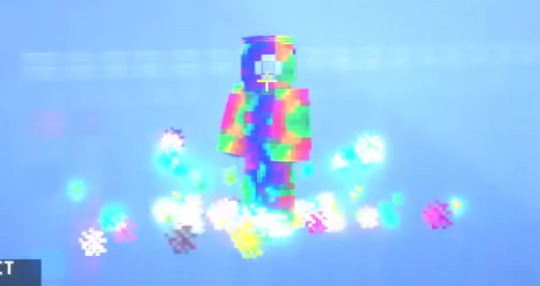




"I AM NOBODY AND EVERYBODY. WE ARE EVERYONE."
"NO! WE WON'T HURT ANYONE!"
"NO NO NO! SHUT UP!"
"We won't forgive him..."
These are some of Chaotic's first lines in the show. Given its recently revealed motives, it makes everything clearer and clearer.
There seem to be the spirits and souls, at least the consciences, of the Chromatics, melded together and moving as one. There are some who are merciful towards the Ores, seemingly accepting of their fate—but others hold the fury that drives them to infect and overtake, color swirling over the land and across the bodies of the mindless infected
"We won't forgive him."
It appears they will do anything they can to return, crawl out from the abyss they were banished to, claw their way from weakness to dominance once again, clearing their path of recognizable Ores until all that is left is that mass of color, anything to return, anything to be worthy again, to be desired and seen and understood again
"We won't forgive him." and who could he be? I assumed it was Origin but apparently he isnt involved,,,
Not forgiving him for taking their lives and leaving them forgotten. A mistake. A simple screw up. Leave it and move on.
But this is nothing new. We've seen the tendency for memory of the past to never quite fade fully— not only the survival of some Chromatics (Red, Blue, Great Librarian), but the remnants of Diamond's memories from LOTB... flashbacks, hallucinations, familiar feelings, wherever they may have returned from. The Creators seem to always let something slide. You'd think they'd all have been erased from existence. So why are they still alive? Why is Chaotic roaming the world why those who sought to keep its original forms dead—do seemingly nothing about it?
Or perhaps they are, and we cannot see it, or maybe the rage and fear of the Chromatic amalgam is so strong that it even overpowers the gods that made it
Maybe it has grown to an equal match against its oppressors.
This is. fascinating to me
#i am so unwell about this show (I LOVE THIS SHOWW INLOEBBE THISHSJOWW)#I CANT PUT I T#ITS#GUUAAAHHH#ore quest: dark#oqd chaotic
6 notes
·
View notes
Text
Napoleon's Marshals and their Birthstones FINAL part
This is the third and final part of the birthstone saga where I'll cover the remaining four birthstones and their marshals (plus two other non-marshals but I wanted to include anyway). I can't believe I spent half of my winter break researching shiny rocks XD
Part 1 and Part 2 are avaliable here
--------------------------------------------------------------
*Mineraloid: A mineral-like object that does NOT contain a crystalline structure.
--------------------------------------------------------------
Sapphire (September)
Marshals- N/A (Honorable mentions: Eugène de Beauharnais & Jean-Andoche Junot)
Type: Mineral
Group: Oxide (Al₂O₃)
Color: Blue, yellow, green, purple
Cleavage: Poor
Fracture: Conchoidal to splintery
Mohs Scale: 9
Luster: Vitreous
Streak: Colorless
Fun Facts: Sapphire is a variety of the mineral corundum and usually comes in the color blue, but it can also come in colors such as yellow, green, and even purple. Its blue hue is due to traces of iron and titanium in its crystal structure. Sapphires, along with the other cardinal gemstones, have a rich history and cultural significance. In ancient Persia and Greece, it was believed that sapphires possessed divine powers and were used in crowns and jewelry of kings and queens. In today’s age, sapphires are used in different objects such as luxury watches, LED lights, and infrared sensor windows used in military aircraft because of their durability (having a hardness of 9, making it the second hardest mineral other than a diamond) and a high melting point of about 3704°F or 2040 °C.
Opal (October)
Marshals- Augereau, Lefebvre, and Grouchy
Type: Mineraloid*
Group: (Hydrated) Silica (SiO₂·nH₂O)
Color: Colorless, white, yellow, blue, green, black, brow, pink
Cleavage: None
Fracture: Conchoidal to uneven
Mohs Scale: 5.5-6
Luster: Waxy
Streak: White
Fun Fact: Opals are formed when water carries pieces of silica inside an open rock or sediment, often found near volcanoes or groundwater. As time passes, the water inside the rock will evaporate, leaving the silica to solidify inside the host rock, which, under specific temperatures and pressure, will begin to form the opal. There are four types of opals: precious, common, matrix, and synthetic opals. Precious opals exhibit what is known as “opalescence,” which happens due to the arrangement of silica inside the opal, creating an array of colorful hues when put under light. Common opals do not possess opalescence; they are either opaque or translucent with one main color present. Matrix opals are opals embedded in their host rock during their formation, and synthetic opals are lab-grown opals that imitate the colorful look of natural opals.
Topaz (November)
Marshals- Berthier and Macdonald
Type: Mineral
Group: Silicate (Al₂SiO₄(F,OH)₂)
Color: Colorless, blue, brown, yellow if impurities are present
Cleavage: Basal (perfect)
Fracture: Subconchoidal to uneven
Mohs Scale: 8
Luster: Vitreous or adamantine
Streak: White
Fun Fact: Topaz gets its name from the Greek word topazion, which refers to the Zabargad Island near the Red Sea, where peridot is also found. Topaz comes in different colors, but the most popular color is blue, the most common color found in jewelry stores [1]. Natural blue topaz is very rare, so to get the color blue, a colorless or pale yellow topaz is heated or irradiated using gamma radiation. Subatomic particles are shot through the topaz at high speeds, which knocks some of the electrons out of orbit, causing the light that travels through the crystal to change and the amount of light absorbed. Due to the color wavelength changing, the human eye perceived the topaz as blue [2].
Turquoise (December)
Marshals- Perrin and Sérurier
Type: Mineral
Group: Phospate (CuAl₆(PO₄)₄(OH)₈·4H₂O)
Color: Turquoise, blue, blue-green
Cleavage: Perfect but rarely seen
Fracture: Conchoidal
Mohs Scale: 5-6
Luster: Waxy or dull
Streak: Blue or white
Fun Fact: Turquoise is another mineral that contains water in its structure; this comes in the form of a hydrated phosphate of either copper or aluminum. Turquoise was one of the first gemstones to be mined, with some jewelry dating back to around 5000 BCE. Even though it has been used in jewelry for thousands of years, its value has decreased due to the treatments and synthetic turquoise appearing more often in the market. Even though they are minerals, well-formed crystals are rarely found on their own, with most turquoise growing closely packed around another mineral, causing it to have a higher durability [3]. Due to its lower hardness level, caring for any turquoise jewelry is important, and it is recommended not to use it while doing any sort of manual labor as the gemstone can be easily damaged. Jewelry designers place a durable bezel around the gem to prevent scratches and protect it. However, the bezel can only protect the gemstone to a limited degree since it is still exposed to open air. It is also recommended not to get the gemstone wet as it can absorb liquids due to its low porosity, which can alter its color [4].
--------------------------------------------------------------
Sources:
Sapphire: MAT, M. (2023, April 24). Sapphire: Properties, formation, occurrence " Geology science. Geology Science. https://geologyscience.com/gemstone/sapphire/?amp
Opal: MAT, M. (2023, September 29). Opal : Properties, formation, uses and deposits " geology science. Geology Science. https://geologyscience.com/gemstone/opal/?amp
Topaz: [1] King, H. M. (n.d.). Blue topaz. Geology. https://geology.com/gemstones/blue-topaz/#treatment
[2] MAT, M. (2023, August 26). Topaz : Gemstone: Properties, formation, occurrence, uses. Geology Science. https://geologyscience.com/minerals/topaz/?amp
Turquoise: [3] MAT, M. (2023, April 23). Turquoise: Mineral properties, uses and occurrence. Geology Science. https://geologyscience.com/gemstone/turquoise/?amp
[4] King, H. M. (n.d.-b). Turquoise. geology. https://geology.com/minerals/turquoise.shtml
#aye Eugene finally makes an appearance on one of my posts :D#napoleonic era#napoleon bonaparte#french history#napoleonic wars#napoleon's marshals#gemstone#birthstone#rocks and minerals#jean andoche junot#eugène de beauharnais
13 notes
·
View notes
Text

Perhaps you are immortal, eternal. But even forever has youth.
tldr; extended, more literature-themed version below the cut!
White diamond, the result of a comet striking the life-filled planet homeworld prime used to be. she drained the planet of its resources and emerged into a nearly dead world, seeing the end of multicelled organisms.
this is her form before splitting off pieces of her that became yellow, blue and pink diamond. yellow and blue each have a clawed hand (the hand that gives off their power!) which is a piece of white diamond herself, hence the lighter color.
white diamond LOVES catergories and organization. she is always seeking to make things better, and for her, the easiest way for that to happen is for everyone to do what they are made to do so she can sit at the top and make the plans for everyone else to follow.
white diamond hates unpredicability. she makes exceptions for the other diamonds sometimes, as they are naturally the flawed pieces of her, but she does have a limit, such as when she banned blue from homeworld prime. now the diamonds seem to scare themselves into obedience without her interference.
when white split herself, she also rendered her essence and physical form weak. she can still create gems at a highly diminished rate but they are extremely fragile. homeworld prime now contains her entire court, now a gargantuan lab dedicated to the progression of technology. most white gems we see in the show are created with the essence of yellow and blue combined with whites; white does not consider these in her court.
she was extraordinary. she could create life at her fingertips, dozens and hundreds if she so chose, but they were imperfect, unorganized. no two were ever the same, an amalgamation of colors and shapes in her eight eyes. at first she blamed the dirt.
but the dirt gave birth to her, did it not? and it did not take long to come to the conclusion that she had, in fact, not been born a paragon, the epitome of perfection. she did things, felt things, wanted things she did not desire. how ugly.
you see, at her core, she loved to catergorize, she loved to sort and put everything into their neat boxes, each item easily identifiable, different, but not among the others in their box. these emotions, these wants and actions did not belong in the same box. she split herself, irreversibly, three times exactly. those parts she did not want, those colors she did not need.
purification came at the cost of pieces of her physical form. but she was pure, and she was logical, and she no longer had any feelings marring her judgement, no impulse, no wants other than to spread her perfection.
and so while her castoffs incubated in that imperfect dirt, forgotten, white finally tried again, this time with success, to create those smaller, lesser beings, in their neat boxes, identical to each other. each snow white, fragile as glass, frail as the life that this planet once supported.
purification, it seems, also stole her essence.
128 notes
·
View notes
Text
Colored Diamonds: Are They Worth the Hype?

When we think of diamonds, we often envision the classic clear, brilliant stones that have adorned engagement rings and necklaces for generations. However, a captivating trend is reshaping the diamond market—colored diamonds. From vibrant blues and pinks to deep greens and yellows, these extraordinary gems are garnering attention and raising questions. Are colored diamonds worth the hype? Let’s explore the allure, market dynamics, and investment potential of these stunning gemstones.
The Allure of Colored Diamonds
Colored diamonds, also known as fancy shape lab grown diamonds, are graded based on their hue, tone, and saturation. Unlike traditional diamonds, which are evaluated on the 4Cs—cut, clarity, color, and carat—colored diamonds are classified by their unique colors and how vivid they are. The more intense and pure the color, the more valuable the diamond.
One of the main attractions of colored diamonds is their rarity. For example, blue and pink diamonds are extremely scarce, making them highly sought after. According to the Gemological Institute of America (GIA), fewer than 0.1% of all diamonds mined are colored diamonds. This rarity not only contributes to their allure but also fuels a thriving market.
The Market Dynamics
The market for colored diamonds has seen significant growth over the past few decades. In recent years, they have become a favorite among celebrities and influencers, often spotted in high-profile engagements and red-carpet events. Notable figures like Elizabeth Taylor and Jennifer Lopez have worn stunning colored diamond jewelry, elevating their status and desirability.
In addition to celebrity endorsements, the rise of social media has amplified the visibility of colored diamonds. Platforms like Instagram and Pinterest showcase breathtaking images of these gems, inspiring potential buyers and collectors. As a result, demand for colored diamonds continues to surge, pushing prices higher.
Investment Potential
When considering the worth of colored diamonds, many prospective buyers and investors wonder about their investment potential. Historically, colored diamonds have shown remarkable resilience in value appreciation. According to a report from Sotheby’s, the auction house has seen colored diamonds sell for millions, with some pieces reaching record-breaking prices.
For instance, the Blue Moon Diamond, a 12.03-carat blue diamond, fetched an astonishing $48.4 million at a Sotheby’s auction in 2015. Similarly, a pink diamond known as the Pink Star sold for $71.2 million in 2017, making it one of the most expensive diamonds ever sold. These high-profile sales indicate that colored diamonds can serve as a stable investment, especially for those looking to diversify their portfolios.
The Risks and Considerations
While colored diamonds present intriguing investment opportunities, they also come with risks and considerations. The market can be volatile, with prices fluctuating based on demand and supply dynamics. Furthermore, the rarity of certain colors does not guarantee a consistent return on investment. For instance, while pink and blue diamonds have historically performed well, other colors may not experience the same level of appreciation.
Potential buyers should also be cautious about the authenticity and certification of colored diamonds. As the market grows, so does the risk of encountering counterfeit or misrepresented stones. It is essential to purchase from reputable dealers and ensure that diamonds come with proper certification from recognized organizations like the GIA.
Choosing the Right Colored Diamond
If you’re considering purchasing a colored diamond, there are several factors to keep in mind. First, determine your budget and desired color. Some colors, like blue and pink, can be significantly more expensive than others, such as yellow or brown. Understanding the market prices for different colors will help you make informed decisions.
Second, consider the diamond's quality based on its hue, tone, and saturation. Vivid and deep colors typically command higher prices, so prioritize these qualities when shopping.
Finally, think about the diamond's setting and style. Colored diamonds can be set in various ways, from traditional solitaire designs to more contemporary styles that showcase their unique hues. Choosing a setting that enhances the color and brilliance of the diamond can significantly impact its overall appeal.
Conclusion
In summary, colored diamonds are undoubtedly worth the hype, offering a blend of beauty, rarity, and investment potential. As demand continues to rise, these stunning gemstones have become more than just luxury accessories; they are seen as viable investments that can appreciate over time.
Whether you're drawn to the idea of owning a vibrant piece of jewelry or considering colored diamonds as an investment, it's essential to do your research and make informed decisions. As the world of colored diamonds evolves, so does the opportunity to enjoy and invest in these extraordinary gems.
For those interested in exploring colored diamonds further, Rahi Impex offers a diverse selection of high-quality diamonds, ensuring that you find the perfect piece that suits your taste and investment goals. Embrace the beauty and allure of colored lab grown diamond, and discover how they can enhance your collection today.
#lab grown diamond manufacturers in surat#lab grown diamond manufacturer#lab grown diamond jewellery india#lab grown diamond manufacturers in india#cvd diamond manufacturers in surat#lab grown diamonds mumbai#lab grown diamond manufacturers#lab grown diamond supplier#lab grown diamond manufacturer in india#lab grown diamond wholesaler#Colored Diamonds#lab grown colored diamonds#lab colored diamonds#lab made colored diamonds#lab created colored diamonds#colored diamonds lab grown#natural colored diamonds#real colored diamonds#blue colored diamonds#lab grown yellow diamond#orange diamond shape#orange color diamond#blue diamond#lab grown blue diamonds#blue lab grown diamonds#green diamond#lab grown green diamond
1 note
·
View note
Text
The Beauty of a Round Cut Lab Grown Diamond Engagement Ring in 14k Rose Gold
Looking for the perfect engagement ring that blends modern ethics with timeless elegance? The Round Cut Lab Grown Diamond Engagement Ring in 14k Rose Gold with a Minimalist Halo Setting might just be the one. Here’s why this beautiful combination has captured the hearts of so many brides-to-be:
🌿 Sustainable Sparkle
Lab-grown diamonds have become a game-changer in the world of fine jewelry. These diamonds are grown in controlled environments that replicate the natural diamond formation process but without the environmental harm of traditional mining. You get the same brilliance and quality as a mined diamond, but with the peace of mind that comes with choosing a sustainable and conflict-free option.
A round cut diamond, known for its unmatched brilliance, is the perfect stone for those who want their engagement ring to radiate light and love. Combine that with a lab-grown diamond, and you’ve got a beautiful piece that’s also kind to the planet.
💕 Why Rose Gold?
Rose gold has a romantic appeal that’s hard to resist. The warm blush tones of 14k rose gold create a soft, dreamy contrast with the dazzling diamond. It’s a unique twist on traditional yellow or white gold that adds a touch of modern sophistication. Plus, rose gold complements all skin tones, making it a versatile and flattering choice for everyday wear.
💫 The Minimalist Halo: Subtle Yet Stunning
If you love the idea of adding a little extra sparkle to your ring, the minimalist halo design is a perfect choice. The halo of smaller diamonds surrounding the center stone enhances the overall shine without overwhelming the ring. It’s elegant, chic, and adds just the right amount of shimmer, making the center diamond the star of the show.
The minimalist design also appeals to those who prefer a sleek, understated look. It’s not too flashy but still radiates enough glamour to make a statement.
💍 Timeless and Meaningful
An engagement ring is more than just a piece of jewelry. It’s a symbol of love, commitment, and a promise of forever. Choosing a ring that reflects both your personal style and values makes the piece even more meaningful. A round cut lab-grown diamond in rose gold with a halo design is perfect for the modern bride who values sustainability, timeless beauty, and subtle elegance.
#diamondring#diamond#diamonds#engagementring#jewelry#ring#jewellery#weddingring#gold#rings#finejewelry#diamondjewelry#love#wedding#engagement#diamondrings#fashion#jewelrydesigner#luxury#diamondnecklace#engagementrings#diamondjewellery
3 notes
·
View notes
Text
Lab Grown Oval Cut Diamond Engagement Ring: A Touch of Modern Elegance
When it comes to celebrating love and commitment, nothing says it quite like a diamond ring. But not just any diamond—a lab-grown oval cut diamond, thoughtfully set in 14k yellow gold, captures elegance in a modern and eco-conscious way. For those who dream of an engagement ring that’s both timeless and ethically crafted, this piece has it all.
The oval cut diamond is known for its elongated shape, which beautifully flatters the hand while maximizing the diamond's brilliance. This particular cut is a symbol of sophistication, but when combined with lab-grown quality, it also becomes a statement of care for the planet. Lab-grown diamonds are crafted with precision, ensuring that every sparkle is ethically sourced and crafted with a lower environmental impact than traditional diamonds.
The 14k yellow gold band adds a warm glow to the ring, creating a luxurious contrast that enhances the diamond's beauty. As an engagement ring or a bridal promise ring, the yellow gold accent gives it a classic touch, yet with a fresh perspective that aligns with today’s values. It’s a perfect choice for brides-to-be who want something meaningful, refined, and distinctly theirs.
If you’re looking for a symbol of enduring love that balances style with sustainability, this lab-grown oval cut diamond ring in 14k yellow gold is a choice that’s as thoughtful as it is beautiful.
#diamondring#diamonds#diamond#engagementring#jewelry#ring#jewellery#weddingring#rings#gold#diamondjewelry#finejewelry#diamondjewellery#diamondnecklace#diamondrings#wedding#jewelrydesigner#love#diamondearrings#engagement#fashion
2 notes
·
View notes
Text
Discover the Magic of Ethical & Exquisite Jewelry at Sophia Manor 💍✨
re you looking for jewelry that combines beauty, craftsmanship, and ethical values? Let us introduce you to Sophia Manor! We’re dedicated to creating timeless pieces that are ethically sourced and crafted with love and care. Whether you’re shopping for an engagement ring, wedding band, or a piece to celebrate yourself, Sophia Manor has something magical for you. Here’s what makes us stand out:

1. Crafted with Love and Unmatched Quality
At Sophia Manor, each piece is handcrafted by talented artisans who take pride in their work. From sparkling diamonds to intricate settings, every detail is meticulously chosen to ensure you receive jewelry that will last for years (and generations!) to come.
Premium Materials: We use high-quality 18k gold, platinum, and lab-grown diamonds to bring out the best in every piece.
Moissanite Magic: Known for its brilliant sparkle, Moissanite is a sustainable, affordable alternative to diamonds that we absolutely adore! 🌈
💍 2. Stunning Engagement Rings & Wedding Bands
Looking to pop the question or celebrate an anniversary? Our collection of engagement rings ranges from classic solitaires to stunning hidden halo and pave designs, with endless custom options to make your dream ring a reality.
Unique Bridal Sets: These sets include an engagement ring and matching wedding band, designed to sit perfectly together for a seamless, sophisticated look.
Customized Options: Choose from a variety of metal colors (white, yellow, rose, or platinum) and diamond cuts to create something that truly feels like “you.”
🌿 3. Ethical & Sustainable Sourcing
Sophia Manor believes in creating beautiful jewelry responsibly. Our lab-grown diamonds and conflict-free stones allow us to offer sustainable, ethical options without sacrificing beauty or quality.
Eco-Friendly Choices: Lab-grown diamonds and Moissanite are just as stunning as mined stones, but they leave a smaller environmental footprint.
Peace of Mind: By choosing Sophia Manor, you’re investing in pieces that reflect both elegance and integrity.
✨ 4. Affordable Luxury with Moissanite
We get it – fine jewelry is an investment! Our Moissanite pieces allow you to indulge in the luxury of fine jewelry without breaking the bank. Moissanite offers a stunning sparkle and is nearly as hard as a diamond, making it a brilliant choice for everyday wear or special occasions.
Diamond-like Brilliance: Moissanite’s exceptional sparkle often exceeds that of a diamond, giving you a show-stopping look at a fraction of the cost.
Durable & Long-Lasting: With a hardness comparable to diamonds, Moissanite jewelry is built to last.
🥂 5. Jewelry for Every Style
From timeless classics to bold, modern designs, Sophia Manor has something for everyone. We offer a range of designs to fit every aesthetic, from minimalists to vintage enthusiasts.
Endless Metal Options: Whether you prefer the warmth of yellow gold, the romance of rose gold, or the elegance of platinum, we’ve got you covered!
Diverse Styles: Our collection includes everything from elegant solitaires to unique vintage-inspired rings, allowing you to find a piece that feels perfect for you.
💖 6. Custom Jewelry for a Truly Unique Experience
Looking for something personal? Our custom design service lets you create pieces that are completely unique to you. From engagement rings to meaningful anniversary gifts, we work with you every step of the way to make your vision a reality.
Bespoke Service: Customize the shape, metal, gemstone, and design details to create something one-of-a-kind.
Perfect for Milestones: Whether it’s a proposal, anniversary, or just a gift for yourself, our custom pieces help you celebrate life’s biggest moments.
Why Choose Sophia Manor?
When you choose Sophia Manor, you’re choosing jewelry that’s as meaningful as it is beautiful. Our commitment to ethical sourcing, quality craftsmanship, and timeless design makes us a trusted choice for those looking for something truly special.
Ready to Discover Your Dream Piece? 💫 Visit our website to explore our full collection or contact us for a personalized consultation. Let Sophia Manor help you find (or create!) the perfect piece that reflects your unique story.
#sophiamanor#ethicaljewelry#moissanitering#engagementring#bridalset#labgrowndiamonds#weddingband#customjewelry#affordableluxury#sustainablejewelry#classicjewelry#customrings#diamondalternative#jewelrydesign#jewelrylovers#tumblrjewelry
2 notes
·
View notes
Text
5 Stunning Lab-Grown Diamond Jewelry Trends for 2024

As we step into 2024, lab-grown diamonds continue to shine brightly in the world of jewelry. Not only are they beautiful, but they’re also more sustainable and affordable than mined diamonds. Here are five stunning trends to watch for this year.
1. Vintage-Inspired Designs
Vintage styles are making a big comeback in 2024. Think intricate filigree settings and art deco patterns. Lab-grown diamonds fit perfectly into these designs, giving them a modern twist while maintaining their classic charm. Whether it’s a delicate ring or a statement necklace, vintage-inspired jewelry can add a touch of elegance to any outfit.
2. Nature-Inspired Jewelry
Nature is always a source of inspiration for jewelry, and this year is no different. Expect to see lab-grown diamonds set in designs that mimic flowers, leaves, and other natural elements. These pieces not only look beautiful but also carry a message of harmony with the environment. Wearing nature-inspired jewelry can remind us of the beauty around us.
3. Colorful Diamonds
While traditional diamonds are often colorless, lab-grown diamonds Jewellery come in a variety of stunning colors, including pink, blue, and yellow. In 2024, colorful diamonds are set to be a major trend. They can add a playful pop to any piece of jewelry. Whether in earrings or pendants, these vibrant stones can showcase your personality and style.
4. Stackable Rings
Stackable rings have become a popular trend, and they’re here to stay in 2024. These rings allow you to mix and match different styles and colors, creating a unique look. Lab-grown diamonds make these rings even more appealing, as you can easily find affordable options that fit your style. Stack them for a bold statement or wear a single ring for a more subtle look.
5. Minimalist Designs
For those who prefer a more understated look, minimalist jewelry is perfect. Simple settings with lab-grown diamonds allow the beauty of the stone to shine without distractions. In 2024, expect to see clean lines and geometric shapes in rings, necklaces, and earrings. This trend is all about elegance and simplicity.
Conclusion
Lab-grown diamonds are not just a trend; they represent a new way of thinking about jewelry. With their stunning designs and ethical considerations, they are becoming the go-to choice for many. Whether you prefer vintage, colorful, or minimalist styles, there’s a lab-grown diamond piece for everyone. As you explore these trends, remember that the best jewelry is the one that reflects your unique personality.
3 notes
·
View notes
Text

Embrace Elegance 4 Carat Oval Engagement Ring with Lab Grown Diamond in 14K Gold 💍 https://www.etsy.com/in-en/shop/RoyalBlueLabDiamond
Choosing an engagement ring is a moment that marks the beginning of a beautiful journey together. The 4 Carat Oval Engagement Ring, adorned with a Lab Grown Diamond set in 14K Gold and featuring a White Diamond certified by GIA/IGI, embodies elegance, ethical sourcing, and exceptional craftsmanship. Let's explore why this ring is a perfect choice for celebrating your love and commitment.
The Timeless Beauty of Oval Cut Diamonds
Oval cut diamonds are celebrated for their brilliance and classic allure. The 4 carat Lab Grown Diamond in this engagement ring showcases the elongated shape and dazzling brilliance that make oval cuts so enchanting. Its sparkle and elegance make it a captivating choice for those who appreciate timeless beauty and sophistication.
Ethical Sourcing and Certification
Ethical sourcing is a fundamental consideration in selecting fine jewelry. The Lab Grown Diamond in this ring is certified by renowned institutions such as GIA (Gemological Institute of America) or IGI (International Gemological Institute), ensuring its authenticity and quality. Lab grown diamonds are cultivated in controlled environments using advanced technology, offering a sustainable and ethical alternative to mined diamonds.
Crafted in 14K Gold
The choice of 14K gold for this engagement ring enhances its allure and durability. Yellow gold's warm tones beautifully complement the brilliance of the oval cut diamond, creating a striking contrast that enhances its beauty. 14K gold is prized for its strength and enduring shine, ensuring that your engagement ring remains as breathtaking as your love story.
Perfect for Your Special Occasion
Whether you're planning a heartfelt proposal or searching for a meaningful gift, the 4 Carat Oval Engagement Ring with a Lab Grown Diamond in 14K Gold is a symbol of sophistication and ethical responsibility. Its exquisite design, combined with the brilliance of the lab grown diamond, makes it a cherished symbol of your commitment and enduring love.
Conclusion
Choosing an engagement ring is a significant decision that reflects your style, values, and the bond you share with your partner. The 4 Carat Oval Engagement Ring with a Lab Grown Diamond in 14K Gold offers a perfect blend of elegance, ethical sourcing, and enduring beauty. Explore our collection today to find the ring that resonates with your unique love story and celebrates the beginning of your journey together.
#labgrown#labgrowndiamonds#diamonds#jewelry#diamond#engagementring#diamondring#jewellery#labgrowndiamond#jewelrymaking#finejewelry#shesaidyes#jewelrydesign#labgrowndiamondjewelry#proposal#love#emerald#jewelrydesigner
4 notes
·
View notes